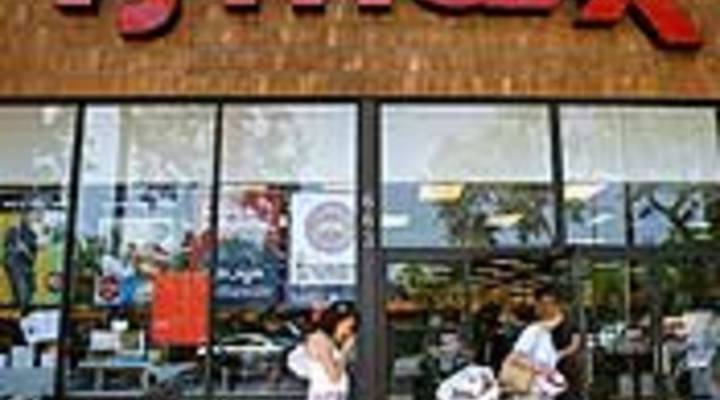
Outlets start acting like full-price stores

TEXT OF STORY
Kai Ryssdal: 2009 wasn’t much fun for most companies in the retail business. For those of us on the other side of the transaction, though, it was pretty good. If you knew where to look, there were some deals to be had. Discount retailers like T.J. Maxx and Nordstrom Rack had shelves that were packed with all the great stuff that full-price stores couldn’t get rid of. But the economy’s a little bit better now. Retailers are a little bit smarter. So discounters are having to get more creative.
As Marketplace’s Stacey Vanek-Smith reports.
STACEY VANEK-SMITH: Last year, nobody paid full-price for anything. Why would they? You could find Coach bags at Ross Dress for Less and Juicy Couture hoodies at Marshall’s.
T.J.Maxx AD: Oh sure, you could pay that crazy boutique price, or get the same bag right now at T.J. Maxx for up to half off. How? Simple…
Really simple. Department stores and boutiques were loaded down with stuff they couldn’t sell. They slashed prices and slashed them again. Still no sales, so retailers cut their losses and unloaded their merchandise. Discounters bought top-shelf brands by the truckload. And frugal shoppers picked up Prada at J.C. Penney prices.
Burt Flickinger is a retail analyst with Strategic Resource Group.
Burt Flickinger: 2009 was the best year in recorded retail history for most of the discount and off-price players.
But discounters and outlets won’t be able to count on runoff from the big retail chains this year.
Matthew Katz is a retail consultant with AlixPartners. He says big department stores and other brand-name retailers have cut inventory way back.
MATTHEW KATZ: The mainstream retailers very quickly shut the spigot off and stopped ordering product. What all the full-price stores are trying to do is minimize the excess.
Katz says, since the recession, $25 billion worth of merchandise has vanished from store shelves, just as the number of off-price stores has shot up. Nordstrom and Saks opened dozens of outlets last year. Bloomingdale’s is launching its first outlets this summer. Online luxury discounters like Gilt and Bluefly have exploded.
Lawrence Cossick heads up online discounter RowNine. He says competition for prime retail runoff is fierce.
Lawrence Cossick: You have to be careful that you find something that’s not readily available in other places, and that’s harder and harder to do quite admittedly.
Cossick says for smaller retailers that means finding a niche. RowNine focuses on big name sunglasses, handbags and jewelry. Larger discounters are taking another tack.
COSSICK: We’ll go directly to the designer and work with them on creating products specifically for our Off 5th customer.
Rob Wallstrom is president of Saks Off 5th. He says these days, leftovers from Saks 5th Avenue only make up about 20 percent of his outlet’s merchandise.
Rob Wallstrom: A little less product is flowing through to us. But we do not have any lack of supply because they’re creating it for us.
Analyst Matthew Katz says lots of outlets are now operating more like full-price stores — bringing in merchandise tailored to their customers, and recognizing that they’re brands of their own now.
KATZ: They’ll have to have to get smart about trends. In the recent past they’ve been buying what has been built and then using that as their selling tools. Today they’re going to have to act with a little bit more foresight.
And designers — whose products ended up in outlets only if they didn’t sell at full price, or had a strange stain on them — are creating looks especially for discounters. After all, that’s where a lot of their customers are now. A survey from Strategic Resource Group found 80 percent of shoppers who had crossed over to discounters during the recession, say they plan to stay there.
I’m Stacey Vanek-Smith for Marketplace.
There’s a lot happening in the world. Through it all, Marketplace is here for you.
You rely on Marketplace to break down the world’s events and tell you how it affects you in a fact-based, approachable way. We rely on your financial support to keep making that possible.
Your donation today powers the independent journalism that you rely on. For just $5/month, you can help sustain Marketplace so we can keep reporting on the things that matter to you.


















